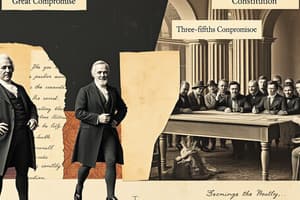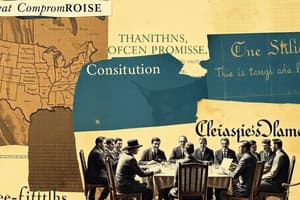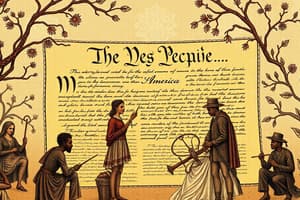Podcast
Questions and Answers
What is the Three Fifths Compromise?
What is the Three Fifths Compromise?
- A document outlining the rights of citizens.
- A plan that proposed equal representation for all states.
- A law that abolished slavery.
- A compromise where every 5 enslaved people counted as 3 in the state's population. (correct)
What was the purpose of the Constitutional Convention?
What was the purpose of the Constitutional Convention?
Leaders came together to change the Articles of Confederation.
What did the Virginia Plan propose?
What did the Virginia Plan propose?
Votes based on population.
What is the New Jersey Plan?
What is the New Jersey Plan?
Who created the Great Compromise?
Who created the Great Compromise?
Federalists supported a weak central government.
Federalists supported a weak central government.
Antifederalists preferred direct democracy and local rule.
Antifederalists preferred direct democracy and local rule.
Who was James Madison?
Who was James Madison?
What is the Constitution?
What is the Constitution?
What does Separation of Powers refer to?
What does Separation of Powers refer to?
What are Checks and Balances?
What are Checks and Balances?
What is the Bill of Rights?
What is the Bill of Rights?
What does it mean to ratify?
What does it mean to ratify?
Flashcards are hidden until you start studying
Study Notes
Three Fifths Compromise
- Established that every five enslaved individuals would count as three persons for state population totals, influencing representation and taxation.
Constitutional Convention
- A gathering of leaders aiming to revise the Articles of Confederation, leading to the creation of a new governance structure.
Virginia Plan
- Proposed by Edmund Randolph, this plan suggested representation in Congress be based on state population sizes.
New Jersey Plan
- Suggested a unicameral legislature with equal representation for each state, regardless of population, countering the Virginia Plan.
Great Compromise
- Formulated by Roger Sherman, this established a bicameral legislature combining elements of both the Virginia and New Jersey Plans - two senators per state in the upper house and representation based on population in the lower house.
Federalists
- Advocated for a strong national government sharing powers with states; supporters of the Constitution, emphasizing the need for a cohesive federal structure.
Antifederalists
- Expressed skepticism towards a strong central government, advocating for direct democracy and local governance to ensure individual rights and freedoms.
James Madison
- Key architect of the new government plan at the Constitutional Convention; later became the fourth President of the United States and a prominent Federalist.
Roger Sherman
- Significant figure responsible for creating the Great Compromise, balancing interests between large and small states.
Constitution
- The foundational legal document establishing the nation's government framework and outlining the processes by which it operates.
Separation of Powers
- A fundamental principle under the Constitution dividing government responsibilities among the legislative, executive, and judicial branches to prevent concentration of power.
Checks and Balances
- Mechanism ensuring that no single branch of government can dominate the others, maintaining a balance of power.
Bill of Rights
- The first ten amendments to the Constitution, formulated to safeguard individual liberties and address Anti-Federalist concerns about government overreach.
Ratify
- The process of formally approving a law or constitutional amendment, requiring the agreement of a specified number of states.
Studying That Suits You
Use AI to generate personalized quizzes and flashcards to suit your learning preferences.




